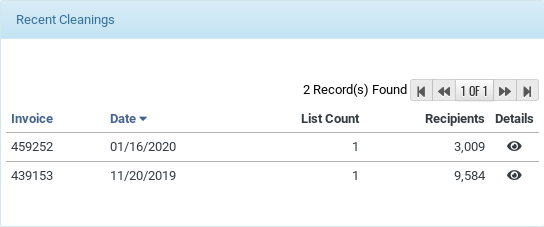Loading the support system

Reporting for List Cleanings can be found on the Report Tab > List Reports > List Cleanings page. Click the eyeball icon  in the Details column to view the full details of any recent List Cleaning.
in the Details column to view the full details of any recent List Cleaning.

Results from a List Cleaning are categorized into 4 groups. Low Risk, and Pass categories are considered safe to email, and as such, both are colored in shades of green on the pie chart below.
Each category covers an array of potential risks and/or threats to successful email delivery results.
High Risk addresses are the most dangerous for your delivery and continuing to these addresses can degrade inbox placement and lead to an increase in soft bounces. This category of addresses are used by email security and blacklisting networks to flag email senders. Some bots and spamtraps are automated and will register clicks and opens on your messages in an attempt to make them harder to detect. Addresses flagged as High Risk may include but are not limited to:
Moderate Risk addresses may pose a risk to email delivery results but are generally not email addresses solely used to identify spam. This category includes but is not limited to:
Low Risk addresses are emails from domains that cannot be verified accurately. Also referred to as catchall domains, these addresses have passed all hygiene tests and deemed safe to email with the understanding this category of addresses may contain elevated rates of invalid email addresses. Hard Bounces that occur during delivery will be deactivated in your sending lists after the first occurrence. (In some API integrations, these results may appear as Minimal Risk.)
Pass addresses have passed all hygiene checks and further Email Validation checks (valid/invalid) have passed.
ReachMail's integrated List Cleaning solution provides Data Hygiene scans which include validation of email addresses but go significantly further:
Email Validation/Verification - Will the address deliver?
Data Hygiene - Will delivery to the address lead to spam folder placement, bounces, or blacklistings?
Data Hygiene starts with how you collect sign up data and extends to how to filter and target recipients for delivery. Targeting message content and reacting to changes in your customer base is key to maintaining inbox placement for your mail. List Cleanings address many list data related problems but are not a substitute for data collection/management best practices. See here for more on data collection best practices.
Confirmed Opt In (COI) sign up forms can help avoid collecting bogus sign ups and other suspect addresses. Bots and Blacklisted domains/emails will try to find their way into open sign up forms online to catch senders with loose data collection practices. The bots aren't necessarily designed to monitor any mail sent their way so they won't confirm a double opt in, or COI sign up.
Regular purging of non-responders is critical, especially for email marketers sending to consumer domains like Gmail or Yahoo. Recycled Bounces are often old, abandoned email addresses that have been reclaimed by the domain and used to monitor senders that aren't paying attention to recipient engagement. Furthermore, consumer networks place a heavy emphasis on recipient engagement from active users when filtering inbound mail. Not only are they using recycled bounces as traps, but they are also grading senders on how engaged their recipients are on a regular basis.
For any additional questions or concerns, please feel free to contact support@reachmail.com.